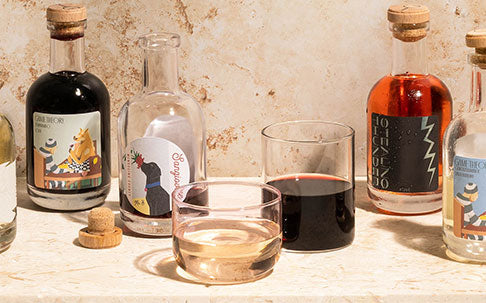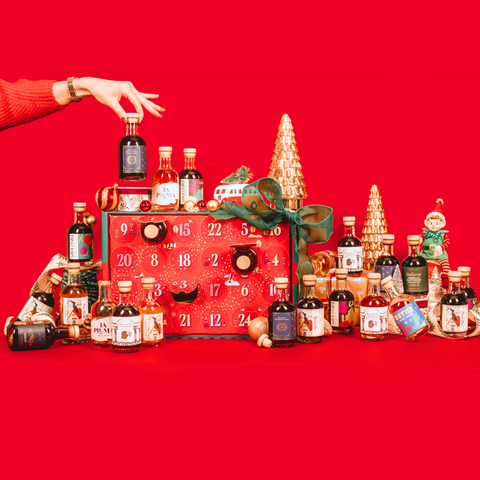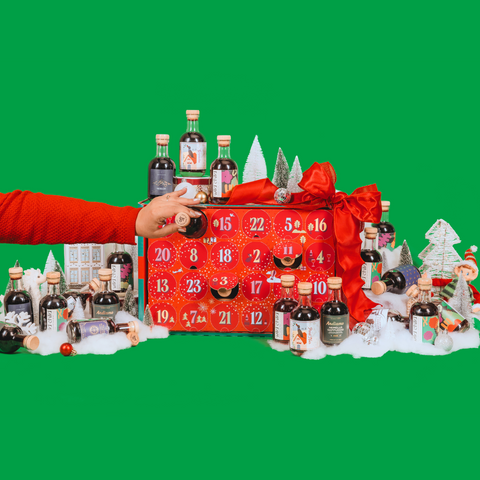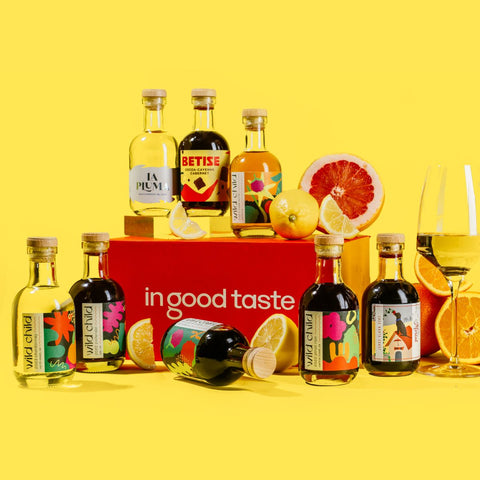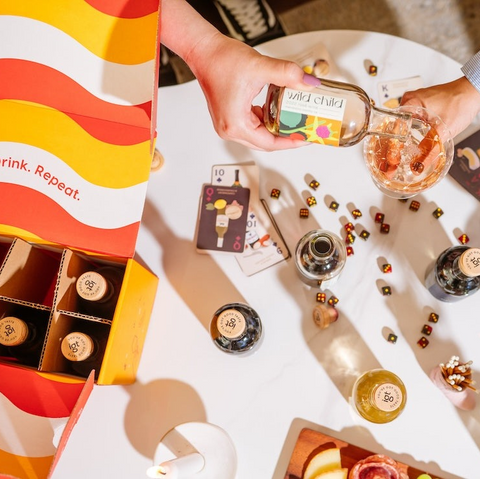Tradition, terroir, and trend are the cornerstones of Sangiovese, an ancient varietal grown throughout the modern world. Sangiovese can survive a variety of climates, but it takes a great viticulturist to create quality wines from this familiar varietal. The Sangiovese grape is the most widely planted varietal in Italy and is one of the most popular red wine types to make its way into New World wineries and vineyards across the globe.
Whether you are talking about the French Nielluccio or classic Tuscan Sangiovese, this fruity red wine has a lot to offer. Regardless of where it’s grown, it exhibits flavors of cherry and tomato and generally exhibits high acidity and tannins. This light red wine is medium-bodied and pairs well with the fruits of the Italian countryside- tomatoes, pasta, pizza, and braised meats.
The balanced flavors of fruit and earth, classic food pairings, and unique history make Sangiovese a must-know varietal for any wine nerd.
A Brief History of Sangiovese
Sangiovese pronunciation, “san-jo-vay-zay,” means “blood of Jupiter” or “blood of Jove” in Italian, named by monks for the Roman god Jupiter. Sangiovese was a popular red table wine in Italy. However, it didn’t gain a reputation for excellence until the late 20th century when Italian winemaker, Bettino Ricasoli, blended 70 percent of potent Sangiovese with 15 percent Canaiolo and 15 percent Malvasia Bianca to create the very first Chianti.
Later, it was combined with grapes like Cabernet Sauvignon, Cabernet Franc, and Merlot to create the more versatile Super Tuscan wines like Tignanello. By the beginning of the 21st century, Sangiovese made up one-tenth of the vines on the Italian peninsula and made inroads in France, California, Australia, and other new world vineyards.
Regions, Terroir, and Regulations
Hot, dry climates with limestone and clay soil produce the best Sangiovese wine. The grape takes a long time to ripen and therefore needs plenty of time to reach its fullest flavor potential. Over the long growing season, Sangiovese develops the richness and body that make it notable. Limestone soil helps winemakers create wines with dazzling aromas and finesse.
Italy is the birthplace of Sangiovese, where 10 percent of all Sangiovese grapes are produced. Production is concentrated in Tuscany but Umbria, Romagna, and Campania also create notable examples of this popular red wine. The French island of Corsica is the second-largest producer followed by Mendoza in Argentina, Napa Valley and Sonoma County in California, Washington state, and Barossa Valley in Australia.
Italy
Sangiovese is the Italian wine that has put Tuscany on the map. As the Latin name implies, the light red wines of Tuscany are closely tied to both religion and art. But Sangiovese also has humble roots as a popular “table” wine served with the lunch and dinner of every Tucan family, both rich and poor
Four of the most important Italian reds- Chianti, Chianti Classico, Brunello di Montalcino, and vino nobile di Montepulciano- come from Tuscany. All four contain a large percentage of Sangiovese.
The rich history and complexity of these four Italian red wine staples are the root of Sangiovese’s popularity. To ensure quality, Italian winemakers imposed strict regulations that define what can and cannot be labeled Chianti, Chinati Classico, Montalcino, and vino nobile di Montepulciano. Certain percentages of Sangiovese, length of aging, and percentage of other varietals (both white and red) must be followed it order to claim these coveted titles.
Chianti is a region in northern Tuscany. The terroir of Chianti produces Sangiovese wines with characteristic acidity and less body. To bear the label “Chianti” the wine must contain at least 70 percent Sangiovese. Unlike Chianti Classico, Chianti wine may also contain 10 percent white wine grapes — a monument to the first Chianti made by Bettino Ricasoli in the 1900s.
Chianti Classico is within the larger region of Chianti but its boundaries are at the heart of the historic region. Chianti Classico wines tend to be of higher quality and age well. They require a minimum of 80 percent Sangiovese and cannot contain any white grapes.
Montalcino is home to the best-known Sangiovese wine, Brunello di Montalcino. This region is south of Siena and is known for the best and brightest examples of Sangiovese. These wines also tend to be the longest-lived.
Brunello is a clone of Sangiovese (also known as Sangiovese Grosso) and its name means “little dark one.” Brunello di Montalcino has the strictest regulations. Regular Brunello needs five years of aging (two of the five need to be in oak, four months in the bottle) and riserva needs six years of aging (two of which need to be in oak, six months in the bottle).
Vino nobile di Montepulciano is not made from montepulciano grapes as the name implies. Instead, this title refers to the location where it must be grown- on the hills around the town of Montepulciano. Wines labeled vino nobile di montepulciano must contain 70 percent Sangiovese. They must be aged for two years (three if riserva) with 12 to 24 months in oak.
A few smaller regions of Italy also produce notable examples of Sangiovese, including Carmignano and Morellino di Scansano.
Carmignano is a small subregion of Chianti to the west of Florence that produces fruity red wine with 50 percent Sangiovese and 10-20 percent Cabernet Sauvignon or Cabernet Franc. The wines tend to have darker fruit flavors and more structure.
Morellino di Scansano is the largest Sangiovese producer in southern Tuscany’s large Maremma region. The former swampland has a balmy climate that produces high acid wines softened by dark cherry fruit. These wines are delicious even without aging, but after two years the riserva bottles develop a structure and depth that make this wine truly exceptional.
France
Corsica produces a variety of Sangiovese called Nielluccio that reflects the specific terroir of this French island. The shrubland of Corsica gives these wines a “maquis characteristic” reflective of the terroir where sage, juniper, heath trees, oak, and myrtle grow in abundance.
Some claim that Nielluccio preceded Sangiovese, and others that it is only a clone of the Italian varietal. Either way, the French Nielluccio wines are similar enough to be cousins of those of the tables of their Italian neighbors. Dark cherry, tomato, black pepper, and herbs are common features of this staple Corsican red.
Argentina
Mendoza houses most of the Sangiovese wines and producers in Argentina. This arid, up-and-coming wine region was introduced to Sangiovese via Italian and Spanish immigrants. Argentinian Sangiovese bottles tend to be jammier, featuring flavors of blueberry and blackberry jam.
United States
Sonoma Country and Napa Valley climates are the perfect blend of fresh ocean air and sunny valley heat. The high acidity of the Sangiovese grape helps it thrive in the warm regions of the north coast.
California is particularly fond of the Super Tuscan wine style- a method in which the winemaker can deviate from traditional styles by adding Cabernet Sauvignon, Cabernet Franc, and Merlot (all popular grapes in California vineyards).
Washington State is an up-and-coming New World wine region. In the far northwest regions of the United States, Sangiovese is often used to make delicious rosés. These delightful summer-friendly wines feature notes like strawberry, cherry candy, and lime zest, making them a refreshing addition to any barbecue.
Australia
Barossa Valley, similar to California, is a hot climate that encourages the production of the high acidity grapes that make Sangiovese great. Sangiovese was one of the first “alternative” varieties introduced to Australia but quickly came a local favorite. Like, Washington state, many of Australia’s wine producers have had success in making rosés from this tricky red varietal.
See, Taste & Smell Notes
Quality Sangiovese wines have lots of acid, firm tannins, and balance on the palate. Cherries and black stonefruit are typical primary notes, with tomato leaf and dried herbs as secondary. Oak aging adds complexity and richness, leading to notes of plums and wild raspberries.
In Italy, winemakers traditionally use chestnut oak barrels to age Sangiovese wines. Modern producers tend to use French oak so that the wines take of the vanilla compounds of the barrels. Either type of barrel causes a malolactic fermentation process which gives wines a softer, rounder mouthfeel.
Discussing the difference between Old and New World wines isn’t as simple as identifying the region or country where the wine was made. Old World Sangiovese tends to be more tannic and acidic than their fruit-forward New World counterparts. However, that is not to say that there aren’t places in Italy making fruity wine from Sangiovese or places in California that produce tannic and acidic wines.
The flavors of Sangiovese wines vary even in Tuscany, where the type of soil, tradition, climate, blending and aging all work together to create great diversity.
Other notes to look for include:
-
Fruits: sour cherry, raspberry, red plum, strawberry, fig
-
Savory herbs: fennel, rosemary, thyme
-
Savory non-fruit: tomato, iron, balsamic, roasted pepper, leather,
-
Clay, brick
-
Tobacco, smoke
-
Dried roses, potpourri
-
Minerality
Room temperature or with a slight chill, Sangiovese is the perfect wine for any season. Chilling the wine will mellow out the tannins, bringing fruit and floral notes to the front. Serve in a small Bordeaux glass for the ultimate tasting experience. The larger bowl and greater surface area will slowly draw out the subtle secondary and tertiary scents as the wine oxidizes. The older the wine, the more complex the smell and taste will become.
Acidity, Tannins in Sangiovese Wine
In Sangiovese, acidity is always going to be more prominent than tannins, but both are characteristic of this medium- to full-bodied red wine. Acidity in wine makes your mouth water, while tannins leave your mouth feeling dry. Both acidity and tannins help the “mouthfeel” of the wine and allow pairings with more rich, flavorful foods.
High acidity wines age better since the acidity preserves the wine and mellows out with age. Tannins will also get more gentle with age. Tannins that were overwhelming when the wine was young will become smoother and rounder with age.
Sangiovese Pairing Notes
Wine and food pairings are all about balance. High acidity calls for lots of fats including butter, olive oil, and meat with a high-fat content like pork. When pairing with a vegetarian meal, a certain amount of butter and olive oil will balance out the high acidity and potent tannins.
Tannins also give a pleasant mouthfeel that pairs well with the salty, umami flavors of cured meats. This makes Sangiovese a great pairing for your next charcuterie board.
The best pairing will depend on the specific wine but the goal is to find balance. Balance the acidity with fat, mellow the tannins with salt, and adjust the sugar content to bring out the more subtle fruit flavors.
When pairing wines, it always helps to think about where the wine originates. Despite worldwide popularity, Sangiovese is native to Italy- home of pasta, tomato sauce, and herbs. The combination of tomato, herbs and Sangiovese brings out the fruit in the wine. This makes Sangiovese a classic pairing with pasta, pizza, and anything that involves tomatoes.
Recipe: Pappardelle Pasta with Slow-Roasted Pork Ragu
A classic home-style meal to serve with your next bottle of Sangiovese is a slow-roasted pork ragu. This pasta dish would be at home in any small Italian countryside home. Ragu is a meat-based tomato sauce, and this version contains fatty, succulent pork shoulder. This recipe makes enough for four people.
-
Ingredients:
-
1 lb of Boneless Pork Shoulder, otherwise known as Boston Butt or pork butt
-
1 large carrot, chopped
-
2 celery stalks, chopped
-
1 onion, chopped
-
4 garlic cloves, minced
-
¼ cup of Sangiovese red wine
-
1 can of crushed tomatoes
-
¼ cup of tomato paste
-
2 cups of pork stock (or chicken, or vegetable)
-
½ teaspoon of thyme, rosemary, and oregano (If using fresh herbs, triple the amount or wait until the end to add them to the sauce)
-
Pappardelle pasta, or wide fettucine, cooked according to package directions
-
Olive oil
-
Instructions:
-
Pork shoulder is the cornerstone of this sauce. Look for a piece with a lot of marbling so that you have plenty of fat to bring out the flavors of your bottle. Start by prepping the soffritto. Soffritto is the classic Italian combination of onions, carrots, and celery. Try to keep the pieces a similar size for even cooking. Finely chop the garlic and set both to the side.
-
Next, brown the sides of each piece of pork to ensure that it holds in the juices during the long braise. Put a little bit of olive oil in the pan on medium-high heat and cook each side of the pork until it’s a nice, crispy golden brown. Once they are browned, pull them out of the pan and set them off to the side.
-
Utilizing the same pan, cook the soffritto and garlic until browned (10-15 minutes). Once the soffritto is ready, use the red wine to deglaze the pan. Scrape the browned bits off the pan bottom with a spatula.
-
Finally, finish building the sauce by adding the tomatoes, tomato paste, stock, herbs, and pork. Bring to a boil then cover and reduce to a simmer. It will take about 2 ½ to 3 hours for the pork to cook enough to fall apart.
-
Transfer the pork to a bowl and use a fork to pull it apart. Mix it back into the sauce to complete your ragu!
-
About 20 minutes before you complete the pork, prepare a pot of boiling water for your pappardelle. Fresh pasta should only take a few minutes. Be sure to save half a cup of pasta water and add it to your completed sauce.
-
Toss the cooked pasta and sauce together. Serve with parmesan, fresh basil, and a glass of Sangiovese. Enjoy!
Tips for Buying Sangiovese
Pay attention to the label next time you see Sangiovese at the store. Sangiovese is the varietal, but the location where it is grown will tell you just as much. Look for Chianti, Brunello di Montalcino, and Super Tuscan wines from Italy, rosés from Washington state and Australia, reds from Sonoma County or Napa Valley, and juicy Sangiovese from Argentina.
In the wine world, higher prices do not always indicate quality. But when it comes to Sangiovese, a high price can indicate longer aging and higher quality which can lead to a tastier, more complex wine. Although the price might not always be right, the investment is worth it when it comes to this popular Italian red. Or you could always try a tasting flight of Wild Child reds to expand your knowledge and try out new varietals.

